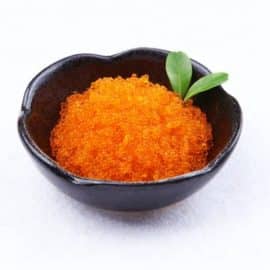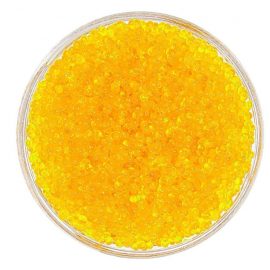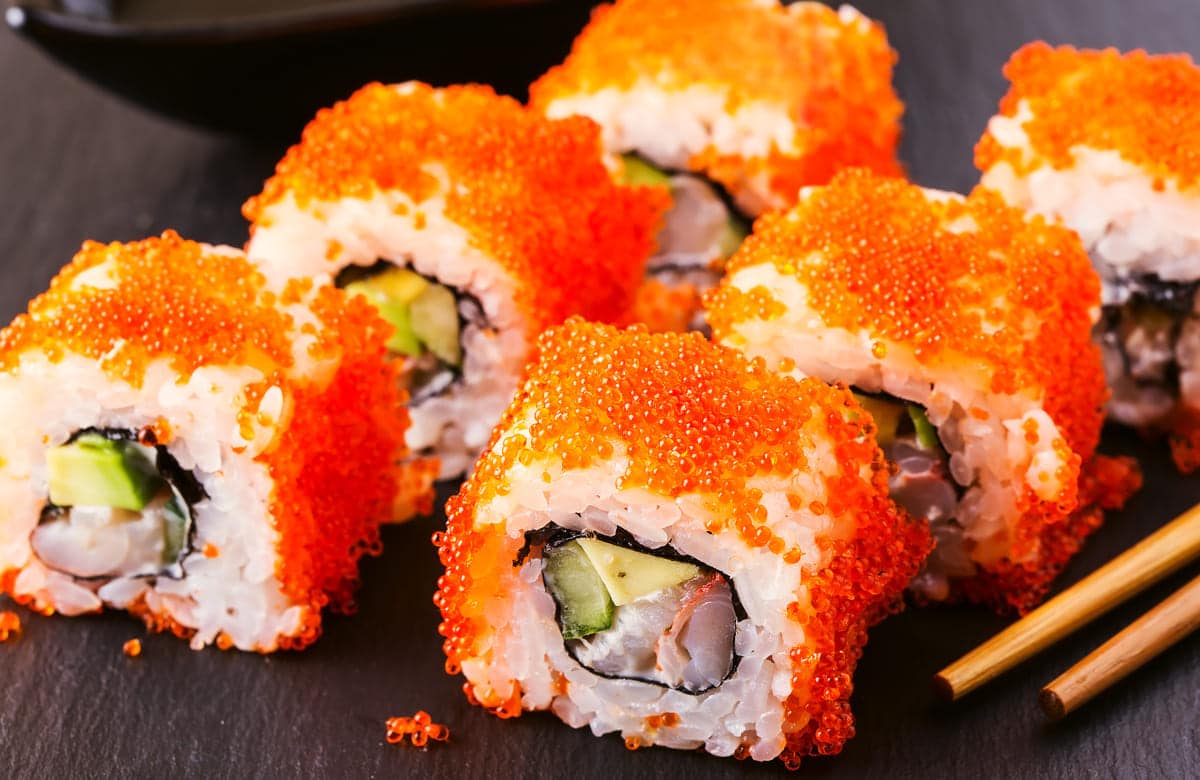
Introduction
The names of plant species, dog breeds, or food types can be unfamiliar.
Your first thought when hearing about Tobiko was that perhaps it was a comic book character name.
The Japanese word tobiko refers to fish eggs or roe, typically obtained from flying fish. It is a type of roe enjoyed as a culinary delicacy in Japan. A variety of fish cakes, sushi rolls, and other dishes utilising seafood can be topped with these colourful fish eggs.
What is Tobiko?
What are those fabulous orange pearls on the sushi? You’re looking at Tobiko.
As an ingredient, tobiko is almost exclusively used in preparing sushi and sashimi in Japanese cuisine. Usually served raw or cooked, it is a flying fish roe.
Typically, tobiko is derived from flying fish such as Cheilopogon Agoo. Known as Japanese flying fish, they are one of the most common fish species.
Smaller than a dime, the eggs range from 0.5 to 0.8 mm in diameter. In terms of size, tobiko is bigger than masago but smaller than ikura. The texture of natural tobiko is crunchy and has a delicate smokiness flavour.
A pinkish-red colour, yellowish colour, vivid green colour, black colour, or white colour depends on the type of fish. The colouring is also achieved using natural substances, like black ink from squids, yuzu for orange tones, and even wasabi to achieve green tones. There can be several pieces of tobiko in a serving, each of which has a distinct colour.
In sushi restaurants, tobiko is frequently sprinkled on top of dishes and placed on sushi rolls to add colour to them.
What is Tobiko made of?
Tobiko is made from the Japanese flying fish roe.
In the process of producing tobiko, the egg is collected from female fish, cleaned to remove any contaminants, and then salt-cured to create a smoky taste and preserve them for more extended storage. A delicious saltiness and satisfying crunchy texture are part of what makes roe so enticing.
Most of the roe comes from Japanese flying fish. Flying fish eggs are harvested from female flying fish. Fishermen and farmers harvest female fish using their natural behaviour displayed by them. As these fish birth their eggs on flotsam, giant seaweed balls are built for them to nest on.
These tiny raw fish eggs are harvested immediately after they are laid in seaweed balls. Keeping male fish from fertilising them is crucial.
Like other fish roe, tobiko must be kept above freezing. It is typical for flying fish eggs to measure a millimetre or less in diameter. The texture and taste would be challenging to describe in just one bite. When eating tobiko, it is most often sucked up by mouthfuls.
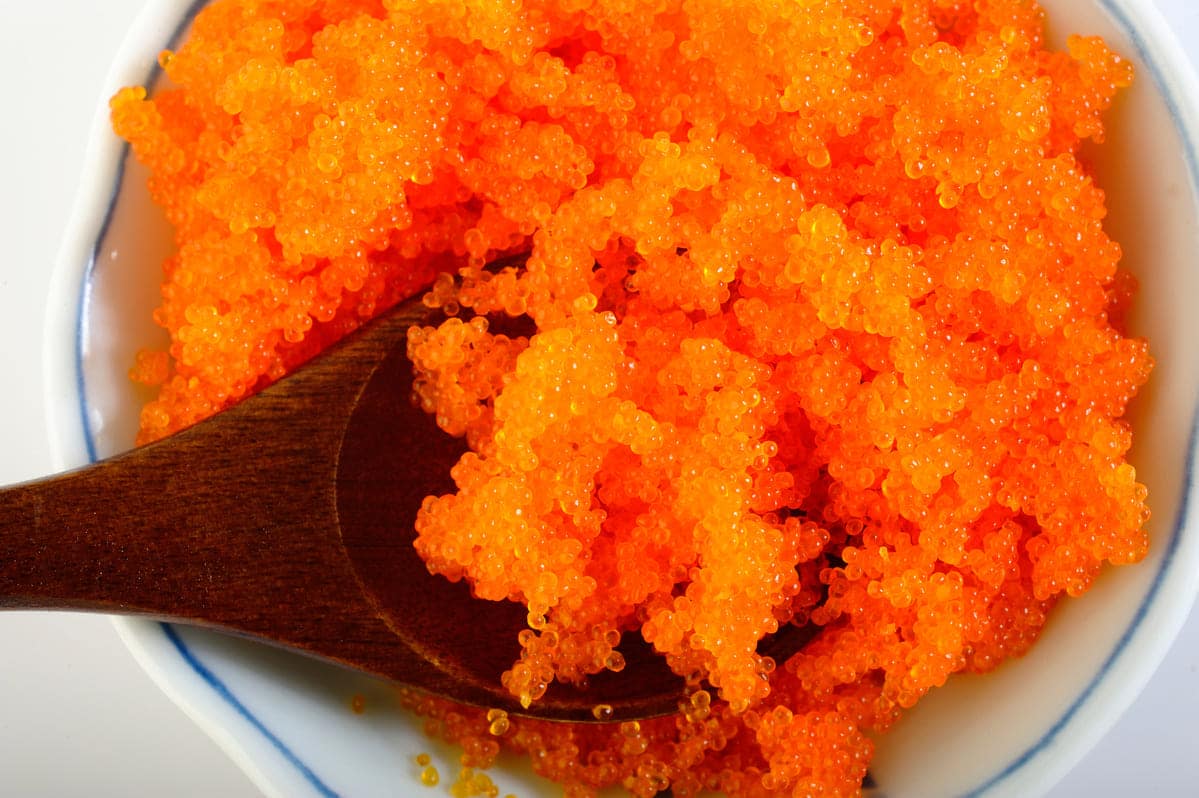
Types of Tobiko
Caviar is a name you might recognise. Nevertheless, there are several types of tobiko, each of which has its characteristics.
Fresh tobiko that is of high quality is cured in salt. The colour will be golden, and the flavour will be sweet and salty. Most tobiko, however, is processed with many additional ingredients besides salt.
The commercialisation of flying fish roe has resulted in a variety of types. Colour can differentiate them, and some have additional ingredients that give them a unique taste and appearance.
Tobiko comes in five colours: yellow, red, black, green, and golden. The colour of the tobiko determines quality.
Black tobiko
It will impart significant flavour, enhanced by the squid ink, and give it a deep black hue. Blue, red, and yellow food dyes can also help produce a striking black colour.
Yellow tobiko
Tobiko will taste and look brighter when citrus fruits, like yuzu, are added. Adding yellow food dye can also enhance the yellow tone.
Red tobiko
It can be coloured with various ingredients, including beets and chillies. Adding chilis to tobiko will give it a spicy and hot taste. Conversely, beets will impart a more subtle, pleasant flavour.
Golden tobiko
You should choose this option if you want tobiko that is fresh and of the highest quality. Only salt is used to cure this type of tobiko, without any food dyes or additives, resulting in a mildly briny taste.
Green tobiko
With fish roe combined with wasabi into it, it has a more intense taste and a clean wasabi flavour. Traditionally, green tobiko is cured and flavoured with salt, sugar, mirin, sake vinegar, soy sauce, and dashi. Colours are often accentuated by using food dye.
When choosing tobiko, consider the dish you want to eat. For example, if you’re going to make a spicy soup, use red tobiko. If you want to serve something cold, go with yellow tobiko.
What does Tobiko taste like? Does Tobiko taste good?
In addition to its attractiveness, tobiko is also famous for its taste. It can also take on a variety of colours while retaining the same form.
Traditionally, this food is salt-cured. Consequently, the taste is salty and smoky. The taste is very different from caviar or ikura due to its sweetness.
Thus, chefs and home cooks can use tobiko in many ways. Tobiko was previously only used in Japanese cuisine, but now it’s becoming popular worldwide, particularly among seafood enthusiasts.
Sukiyaki, tempura, and oden often contain tobiko.
As masago looks similar to tobiko, it is often substituted when tobiko is unavailable.
Tobiko vs Caviar
Some people love caviar, and some people hate it. It’s no secret to fans that the delicacy takes a lot of effort to produce. A substitute cannot replace the real thing. Tobiko is becoming increasingly popular among foodies, exemplary fine food specialist, and chefs.
“Flying fish roe” is primarily used in Japanese cuisine as a garnish, but chefs worldwide are exploring its versatility. Soups and salads can benefit from its addition.
Tobiko is much cheaper than caviar. Caviar is a labour-intensive product. Caviar is tasty, but many people find it too rich and intense.
Tobiko vs Masago
Tobiko and masago have similar appearances and are used for the same sushi preparations. And both fish roes have similar colour varieties, as well. Masago and tobiko each have clean flavours that are mildly salty and sweet.
The two types of tobiko and masago also differ in some crucial ways. Masago is slightly smaller than tobiko. The difference is most apparent when comparing them closely. Another significant difference is how crunchy the tobiko is compared to the masago. The pop of tobiko is gratifying, while the softness of masago is more subtle.
Smelt roe and flying fish roe both have different flavours. Although both are mild, masago has a more delicate taste. It usually has a smoky umami due to the dashi or dashi extract used in the curing process. A tangier taste is also present.
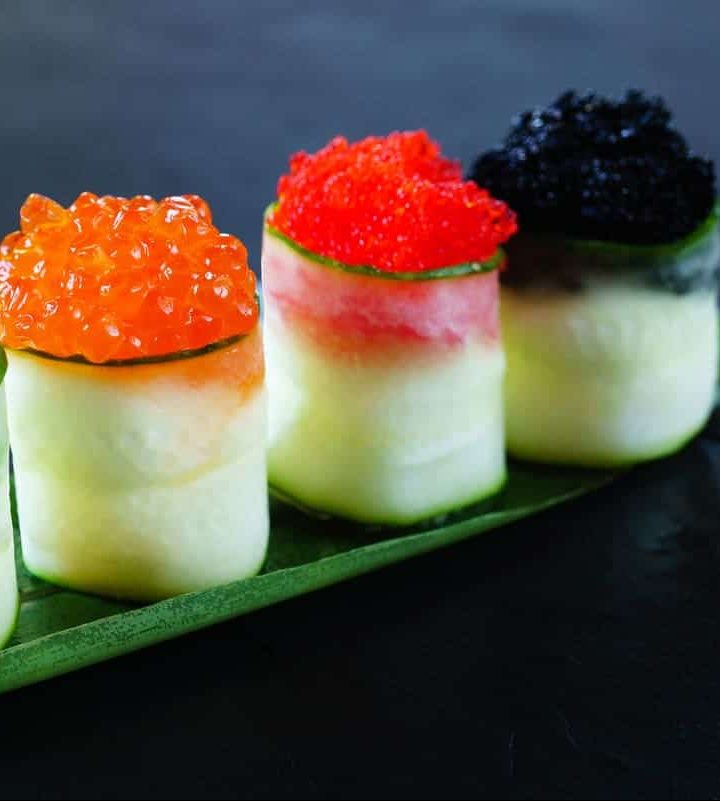
Finally, tobiko is often cured with sake vinegar and mirin. Masago generally does not. Thus, tobiko usually tastes like sweet rice and vinegar.
Tobiko vs ikura
Tobiko and ikura are both fish-based toppings for sushi. However, they differ in a few ways. Tobiko is primarily derived from flying fish, hence the name “flying fish roe”, while ikura is obtained from salmon trout.
Although the calorie content of these fish varies with the species, they are generally low in calories, as they are usually served with sushi.
Health benefits of Tobiko
The consumption amount and your diet will determine how healthy they are for you.
Low in carbs
A serving of tobiko has only one gram of carbs. Protein, fibre, and fat are all provided by it as well.
Rich in Omega 3
Tobiko contains a high amount of omega-3 fatty acids. The omega-3 fatty acids contained in 100g of Tobiko are about 8,700mg. In addition to protecting the heart, omega-3 fatty acids also aid in lowering the risk of chronic illnesses.
Protein-rich
It also contains protein, which is essential in tissue repair, regulating fluid levels, and delivering oxygen to the body. Protein-rich fish roe products make excellent pantry staples.
Nutrient-dense
Protein and minerals are abundant in tobiko. It also contains essential nutrients and vitamins A, B12, D, and E. Consuming it is an excellent way to stay energetic and stay full for longer.
Buying Tobiko
Japanese restaurants often serve tobiko. Using them to prepare sushi at home, however, will require a little research.
Tobiko is sold frozen in some Asian markets, including Chinese markets. It’s also worth checking out premium seafood markets. In small packs, you can find it in the section dedicated to seafood. Different colours and tastes are available, so you have plenty of options. As a preservation measure, most tobiko is processed extensively and seasoned thoroughly.
Tobiko is made from flying fish, which are kosher species. Kosher certification is required for tobiko to be considered kosher. Tobiko is also regarded as Halal. Consumption of this product is permitted.
Tobiko can be bought online most easily and cheaply in most parts of the country. The online marketplaces allow you to order and deliver it to your door.
Proper Storage of Tobiko
As for its texture and taste, tobiko can be frozen without losing its quality. After they have thawed, store them in the refrigerator. The best way to enjoy them is within three to four days.
It can be a delicious breakfast in just 5 minutes with ingredients prepared the previous night. Store the ingredients in zip-lock bags the night before.
Several months can be spent freezing tobiko. Eat the thawed tobiko within three to four days after it’s been defrosted.
Serving Tobiko
There are many ways to enjoy tobiko since its actual product packaging is robust and versatile.
Common methods
Tobiko is commonly used as a topping in Japanese cuisine. You can use the most prized sushi roe in tobiko nigiri, one of the Japanese delicacies. It comprises a stack of vinegared sushi rice topped with raw fish and wasabi. To make it even more delicious, sprinkle some tobiko on top.
Tobiko is also used in sushi rolls. The California roll is also made with it these days. Add it to rice dishes and seafood dishes as a garnish. On toast or plain crackers, tobiko can be served as a tasty starter.
Further, tobiko is also present in sashimi dishes. Simple yet delicious, this kind of sushi consists of raw fish that is thinly sliced, typically accompanied by soy sauce, with tobiko or avocado thrown in for good measure. With this method, each bite of sashimi can have a bit of tobiko.
There are several ways in which tobiko can be cooked. The roe can be fried with breadcrumbs, sautéed in a pan, or poached. It is not advisable to add salt to salted tobiko for fear of oversalting it.
Dressings, sauces, soups, and salads benefit from the subtle saltiness of tobiko.
Food pairing with Tobiko
The culinary world uses tobiko in numerous ways. Dishes with salty, savoury flavours complement its smooth, creamy consistency and mildly sweet and smoky taste. Although tobiko can be used creatively in steamed rice or omelettes, Japanese food uses it the most.
Seaweed wraps around white rice, with tobiko placed on top. The yolk of a quail egg can add an appealing flavour to an everyday meal.
The smokiness of tobiko complements raw fish, nori, sushi rice, green salads and vegetables used in sushi. Sushi is available in many different styles, so the many types of tobiko serve as a great accompaniment to sushi.
Tobiko needs to be more complex for it to be served alone. Rather than acting as a leading character, it plays a better supporting role when the meal is viewed in perspective. The fact that it can enhance your favourite Japanese dishes is worth considering when selecting a sushi plate. It will depend on the colour of the tobiko on your plate, but you can expect it to add flavour to your dish.
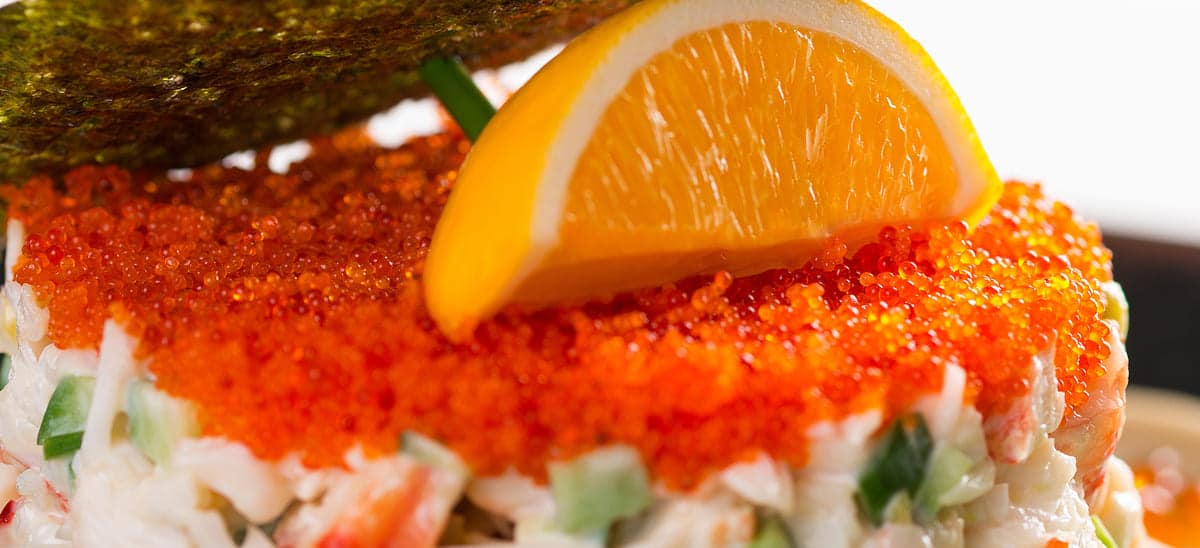
Pairing drinks with Tobiko
There are a variety of alcoholic drinks that pair well with tobiko. There is a strong focus on fish roe in these beverages. They are best paired with sashimi and gunkan dishes.
Sake
Tobiko pairs well with sake. Make sure the sake you choose is just a little deep or earthy.
It also makes a great match when you have sparkling sake, typically sweet. Fish roe adds rich umami to the sweetness of the rice. The acidity and bubbles together help to remove taste impurities.
Beer
If the beer isn’t too strong, beer and fish roe go well together. The best choice would be light ales. Tobiko can, however, be enjoyed with a German or Czech beer that is flavourful and richer than Japanese beer.
Wines
Sparkling wines with fruity notes are also an excellent pairing choice, as are sparkling sakes. You can’t go wrong with Prosecco too. Also good is Moscato d’Asti, especially when combined with wasabi tobiko.
Many types of fish roe can be paired with dry sparkling wines without harming the palate, such as Cava or Champagne.
Flying fish and smelt roe pair well with white wines. Especially with wines containing brine or minerals and wines with sugar residuals.
Santorini Assyrtiko, Muscadet, and Chablis are some of the best. The wines in this category go well with various other Japanese dishes.
Vodka
There is nothing more classic than vodka and tobiko. Honkaku rice shochu or barley shochu is an excellent variation of this concept.
Popular Tobiko recipes to look out for
Tobiko sushi
Tobiko sushi is made with seaweed paper, imitation crab meat, cucumbers, avocados, pickles, and wasabi.
No introduction is necessary for sushi lovers. A great flavour enhancer is tobiko sushi! Tobiko sushi rolls are filled with various kinds of seafood and avocado. Most commonly, they are made with tobiko roe.
When buying tobiko, look for bright orange or red coloured roe. You can buy them both online and at your local market.
Tobiko omelette
Next time you have a meal, it will be delicious with this omelette with tobiko. Since the fish roe is naturally salty and seasoned, only a few seasonings are required for the egg. You should avoid overcooking the egg in the pan to ensure a moist and soft omelette.
Tobiko salmon mayo rice
You’ll love this savoury recipe if you love seafood. Almost like a buttery sauce, it tastes like the ocean. Salmon and tobiko sauce are served on mayo rice mixed with nori.
Angelhair pasta with tobiko caviar
It’s surprisingly flavorful, given its simplicity, and it takes just minutes to make. Sturgeon caviar can be substituted for flying fish roe if you wish to treat yourself.
Tobiko caviar, peeled amaebi, and shiso leaves or flowers can be found in any Japanese ingredient store.
Tobiko substitutes
Ikura salmon roe is considered Japanese caviar and is used in the same way as Tobiko. The ikura is gooey inside and has a fishier flavour than tobiko. In addition, it makes an excellent garnish because of its shimmering appearance.
Another great alternative is masago, which is cheaper and much softer.
Sustainability of Tobiko
Flying fish are found throughout the world in a wide variety of species. Fish eggs are popular as tobiko, and the meat of the fish is also popular. Several fisheries exist for adults as well as flying fish eggs.
As a result of egg harvesting, flying fish will grow smaller. Healthy populations can be found near Taiwan, the Japanese south coast, and the East China Sea. There is, however, a risk of excessive fishing.

